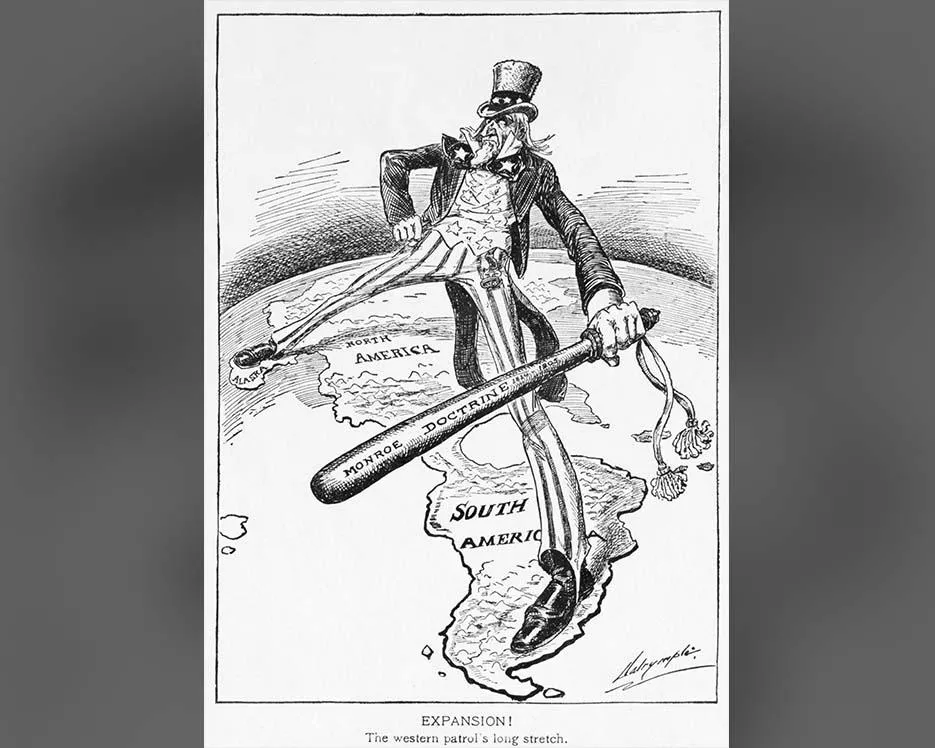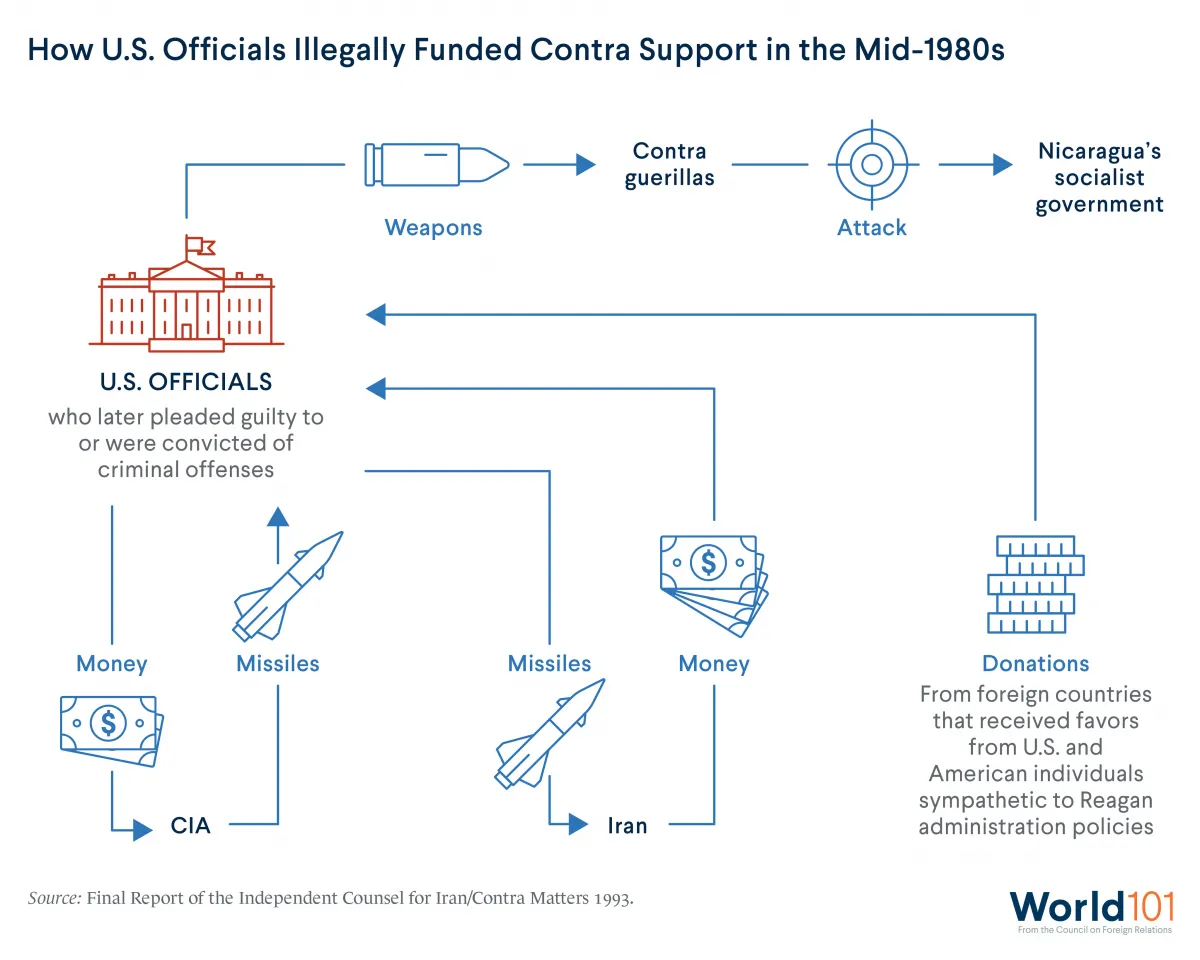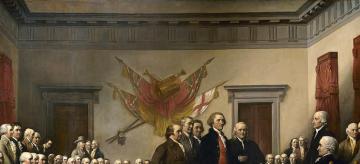U.S. Foreign Policy: The Americas
Since the 1800s, the United States has positioned itself as the preeminent power in the Americas.
Since the 1800s, the United States has positioned itself as the preeminent power in the Americas. Early U.S. administrations declared that the region should be free of foreign (mainly European) interference. As the United States grew in size, wealth, and military power, it began to make this vision a reality. Throughout the twentieth century, fearing the spread of communism across the Atlantic Ocean and looking out for the interests of U.S. businesses operating in Latin America and the Caribbean, various U.S. administrations intervened throughout the region, toppling unfriendly—but often democratically elected—governments. These interventions frequently empowered dictatorships that supported U.S. interests but committed human rights abuses. Tens of thousands of people disappeared under these violent regimes, with millions more seeking refuge in neighboring countries. Today, the United States continues to grapple with the effects of its past interventions while addressing other regional challenges, such as those related to drug cartels, economic stability, and migration.
Monroe Doctrine and Roosevelt Corollary Form Basis of U.S. Interventionism
The United States has considered the Americas its sphere of influence since the early nineteenth century. In 1823, President James Monroe warned Europe’s imperial powers not to interfere in the Americas, fearing Spain and France in particular would recolonize the region. The so-called Monroe Doctrine, while bold, went largely unnoticed by European countries, which stayed out of the Americas for reasons of their own. At the dawn of the twentieth century, President Theodore Roosevelt amended the Monroe Doctrine to include a more muscular policy, known as the Roosevelt Corollary. Now the United States would not only act against European powers trying to extend their influence in the Americas, but would also directly intervene in regional countries that it saw as weak, unstable, or in any other way vulnerable to foreign influence. Soon the United States was intervening throughout the region, often to advance its own interests rather than just to prevent European influence.
Good Neighbor Policy a Brief Interlude From Interventionism
President Franklin D. Roosevelt tried to establish a different kind of relationship between the United States and Latin America—one predicated on trade and diplomacy rather than military intervention. In 1915, President Woodrow Wilson ordered U.S. marines to occupy Haiti in a bid to foster democracy, promote U.S. economic interests, and deter other foreign influence from the Caribbean country. In 1934, Roosevelt withdrew American troops from Haiti and focused instead on developing the country’s economy. His approach, known as the Good Neighbor policy, ended U.S. occupations in countries like Haiti and Nicaragua. But the Good Neighbor policy proved short-lived, as the advent of the Cold War saw the subsequent return to interventionism by U.S. administrations.
U.S. Business Interests Drive Foreign Policy
In the first half of the twentieth century, many American businesses—especially agricultural businesses—invested heavily in Latin American countries. For example, the Boston-based United Fruit Company (UFC) purchased plantations throughout Guatemala, where they grew bananas for export. On a number of occasions, these companies pressured the U.S. government to intervene to protect their investments. In 1951, Guatemala elected Jacobo Arbenz president on a platform of redistributing land to low-income Guatemalans. Fearing for its plantations, the UFC, launched a three-year lobbying effort costing $5 million in today’s dollars to convince the U.S. government that Arbenz’s policies suggested Soviet influence. The CIA orchestrated a coup that ushered in decades of military rule that, while repressive and undemocratic, protected the UFC’s land holdings. This incident and others like it left many Latin Americans deeply distrustful of U.S. motives in the region.
Cuban Revolution Causes Major Concern in United States
Fidel Castro’s 1959 rise to power in Cuba through a communist revolution alarmed the U.S. government for many reasons. The establishment of the first communist government in the Americas—particularly in a place where the United States had once exerted significant influence—was seen as a major defeat in the Cold War. Meanwhile, Castro’s close relationship with Moscow raised the specter of European influence in the Americas, long barred by the Monroe Doctrine. And U.S. businesses were deeply concerned when Castro’s socialist government seized over a billion dollars in U.S. assets in Cuba. President John F. Kennedy reacted by announcing an initiative called the Alliance for Progress, which aimed to reinforce Latin American countries against communist takeover through U.S. foreign aid. At the same time, the CIA was secretly planning to send anti-Castro Cubans from the United States to Cuba’s Bay of Pigs to stir up a counterrevolution. The 1961 invasion failed, serving only to push Castro closer to the Soviet Union and reinforce the image of U.S. foreign policy in the Americas as interventionist, despite the Alliance for Progress’ more diplomatic approach.
United States Fights Communism in Latin America
Fearing communism’s spread to the West, the United States backed a series of military coups in the 1960s and 1970s against left-leaning governments in Latin America, expecting leaders with socialist policies to ally with the Soviet Union. For example, in 1970 Chileans elected Salvador Allende president—a leader who was committed to the democratic system and rule of law but worked to establish a socialist economic policy. The United States, concerned by Allende’s socialist ideas and their implications for U.S. businesses in Chile, supported the Chilean military’s overthrow of Allende in 1973 in favor of a council of unelected military leaders, or junta. The council was succeeded by General Augusto Pinochet, who ruled Chile as a dictator until 1990. Pinochet’s rule saw massive human rights violations including the extensive use of torture and forced disappearances, in which the government would kidnap and kill people, then deny victims’ families any knowledge of what had happened.
United States Takes War on Drugs to Colombia
In 1971, President Richard M. Nixon declared a war on drugs in the United States. For decades, that war has involved both cracking down on drug consumption at home and trying to prevent illegal drugs—especially cocaine—from being grown and processed in Latin America. In 2000, the United States launched Plan Colombia, a multibillion-dollar, bipartisan initiative to train Colombia’s police and military forces in strategies to shut down its drug trade while respecting human rights. The program also sought to strengthen Colombia’s economy, improve its democratic institutions, and combat leftist guerrillas and right-wing militias that had sunk the country into conflict for generations. Now, twenty years after the program’s inception, Colombia is a changed country. Decades of war with the FARC (Colombia’s left-wing rebel group) have ended, the country’s economy is prospering, and the homicide rate is at its lowest point since 1975. But Plan Colombia’s crop eradication efforts have also led to violence and displacement—and in 2018, coca production in Colombia hit an all-time high.
Iran-Contra Affair Leads to Consequences for Intervention
In 1986, an intervention in Latin America led to consequences for the U.S. government. U.S. officials had, for much of the 1980s, been sending money to anti-communist guerrillas known as the Contras in Nicaragua despite a congressional ban on such aid. Some of the money sent to the Contras came from secret arms sales to Iran at a time when U.S.-Iranian relations were hostile. News of the arrangement eventually leaked in 1986, and the ensuing disclosures and congressional investigation were a major source of embarrassment, revealing the U.S. government’s two-faced policy toward Iran and determination to continue to interfere in Latin America, even to the extent of breaking U.S. law. Ultimately, a number of government officials, including the secretary of defense, faced criminal prosecution as a result of what became known as the Iran-Contra Affair. More importantly, the scandal led to greater congressional and public scrutiny of covert actions abroad and of U.S. foreign policy in general.
NAFTA Becomes Poster Child for Battle Over Globalization
In 1994, the Americas became the home of one of the most ambitious free trade agreements ever written, as the United States, Canada, and Mexico signed the North American Free Trade Agreement (NAFTA). NAFTA was designed to increase trade among the three countries by removing or lowering trade barriers like tariffs and quotas. As with globalization generally, NAFTA brought both benefits and costs to North American countries. In Mexico, the agreement spurred manufacturing, which increased exports and in turn grew the Mexican middle class. But it also eliminated some jobs across the region, stirring sharp opposition among farmers who felt that they could not compete with the influx of cheap imports. In the United States, the deal has similarly become a symbol in the larger debate over globalization. Anti-globalization concerns about manufacturing jobs moving overseas helped elect President Donald Trump, who promised to renegotiate NAFTA to get a better deal for American workers. In 2018, the three countries signed a revised trade deal called the U.S.-Mexico-Canada Agreement, which updated NAFTA with new laws on the internet and intellectual property and restructured agreements on dairy and manufacturing businesses.
U.S. Foreign Policy Has Contributed to Migration—and Could Mitigate It
In 2017, about 3.5 million Central American immigrants were living in the United States. Most came from El Salvador, Guatemala, and Honduras, which are often referred to as the Northern Triangle. Within those three countries, homicide rates are high and corruption is endemic. Although political instability and violence in the region predate U.S. involvement, some experts argue interventions by the United States in the twentieth century—including its support of military groups in El Salvador, a coup in Guatemala, and right-wing insurgents in Honduras—exacerbated existing conditions in these countries and contributed to regional upheaval. Of the Central American immigrants living in the United States, approximately 1.9 million are undocumented. As the debate over immigration to the United States continues, some have suggested that new policies toward Central America should address the root causes of this migration, using U.S. foreign aid to facilitate economic and political stability.










